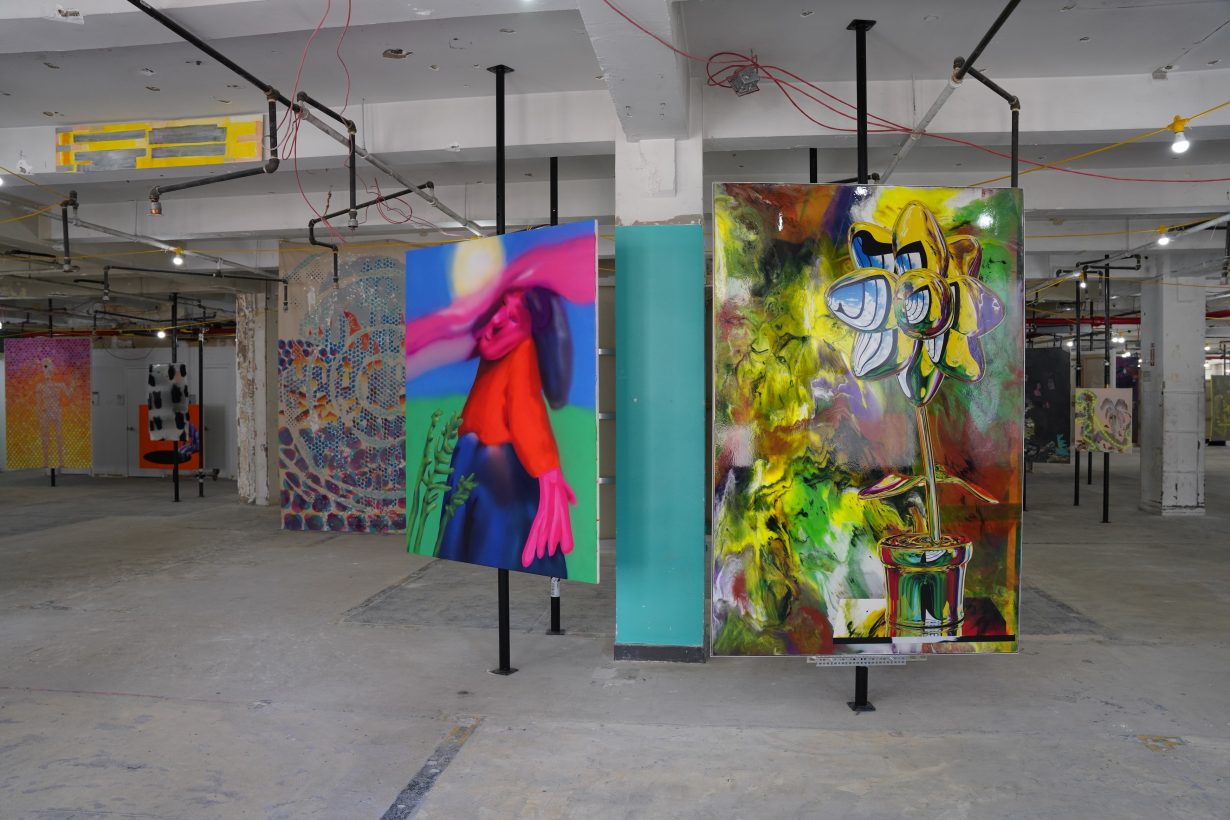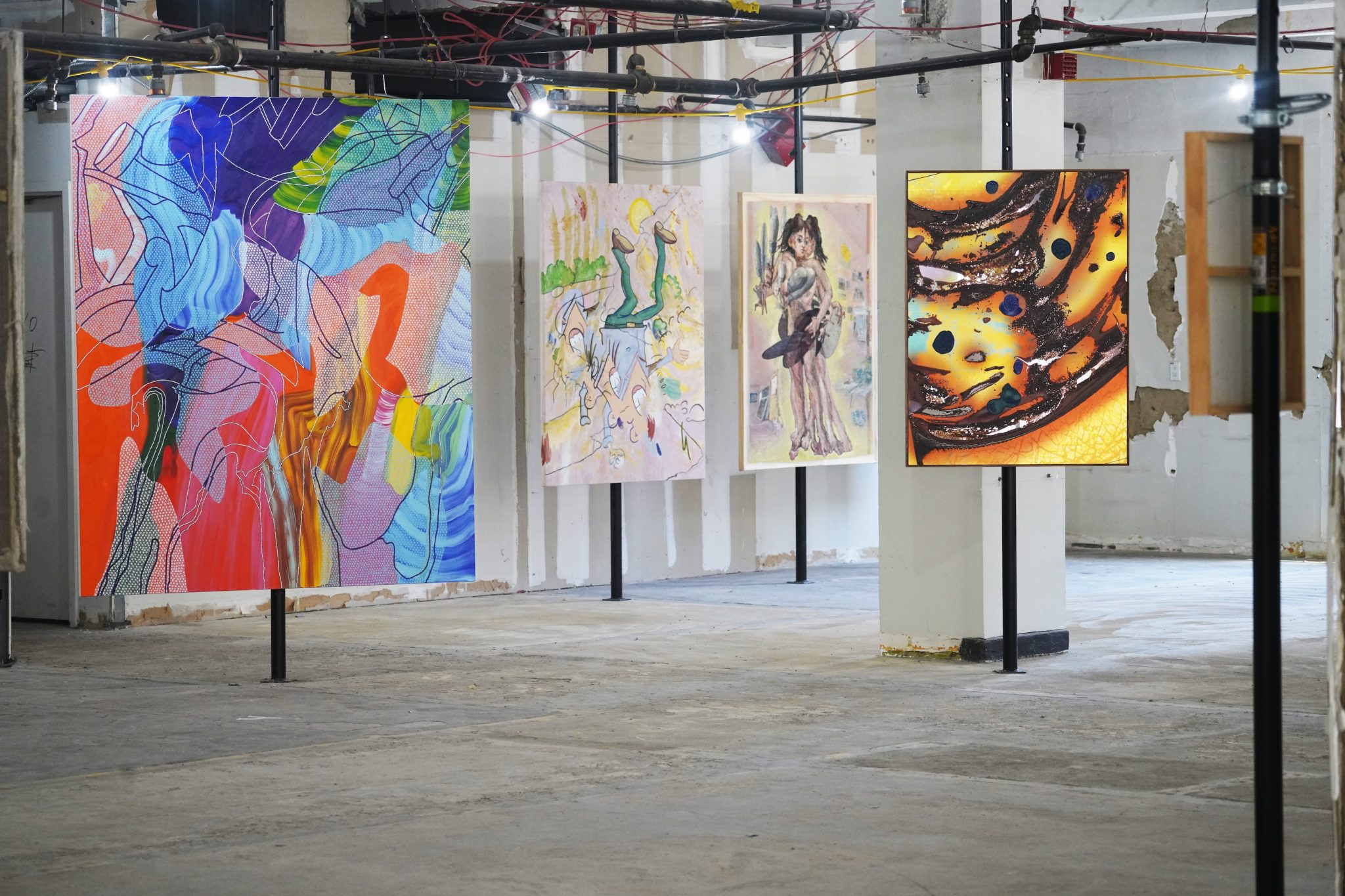An exhibition made in the afterimage of Bernadette Corporation adopts ‘sloppiness’ as a brazen curatorial strategy that fails to coalesce
After Frieze Week I had no desire to leave my apartment, so I read a couple of novels in bed. One of them was Reena Spaulings (2004), a book written by a group of anonymous authors associated with Bernadette Corporation (BC), a fashion and filmmaking collective founded in 1994 when artist Bernadette Van-Huy was approached by the infamous nightclub promoter Michael Alig to throw a series of parties at Club USA in Times Square. ‘Imagine Gossip Girl being rewritten by a Situationist’, John Kelsey, another of BC’s principal members, said in an interview, regarding Reena Spaulings. According to its preface, the novel is ‘generic and perfect’.
Reena, the protagonist, could have been ‘just about anybody’ in their twenties who was photogenic and part of the downtown scene during the ‘panic of good times’ that was the early 2000s. When we first meet her, she is working as a museum guard at the Met; before long, she is spotted by Maris Parings, an entrepreneur with ‘a knack for extracting bodies from cities’, and whisked away to model lingerie and attend fundraising banquets where Donald Trump and Slavoj Žižek make brief cameos. After bursts of inclement weather, sex and protests, Maris engineers Battle on Broadway, a ‘musical riot’ and ‘live spectacle featuring Reena Spaulings’, during whose climax Reena is grazed by a bullet. Her wound is shallow enough to be dressed using ‘cocktail napkins and tape’, but nevertheless the book ends with Reena declaring New York dead and decamping to Milan.
Van-Huy once said, with regards to BC, which became legally incorporated in 1995, ‘We’re trying to create products that incorporate a critique from within.’ Reena Spaulings certainly fits the bill for a story that criticises late capitalism while fully inhabiting its played-out tropes. There is a self-acknowledged ‘sloppiness’ to BC’s prolific, cross-disciplinary and sporadically archived practice that crops up in the novel, too: by jettisoning individual authorial responsibility, members of BC gave themselves room to experiment with literary form and content. Long, obsessive digressions and random point-of-view shifts imbue the novel with the intoxicating aura of freedom and collective frisson. In 2004 Kelsey joined up with painter Emily Sundblad and founded Reena Spaulings Fine Art, a commercial gallery still operating in the Lower East Side, which sought to compete within the traditional market system while giving artists a similar kind of freedom to experiment, to act as if they were not inside the system at all. This model resulted in exhibitions where paintings were made onsite during the vernissage (Merlin Carpenter, 2007), or the gallery was used to house pigeons (Klara Lidén, 2008).

RSFA had been name-checked in the press materials of R U Still Painting???, a big, ‘arbitrary, non-national, non-rational, unofficial and incomplete painting survey’ that opened in a temporary gallery space in a Midtown Manhattan highrise the night before the VIP previews of this year’s spring fairs, curated by a new (to me) artist collective called FALCON. Specifically, a line from a manifesto couched in a questionnaire between FALCON founders Paololuca Barbieri Marchi and Marco Boggio Sella and an anonymous interlocutor (in all likelihood their PR rep) had called the show ‘a wink tothe 2000s DIY scene – loft shows, warehouse pop-ups, and artist-run galleries like Reena Spaulings, where artists curated other artists’. I’d gone up to R U Still Painting??? the night it opened, at around 10 pm, tempted by the prospect of encountering something unfamiliar, something unruly, recalcitrant and difficult that highrise ‘takeovers’ in recent memory (Christopher Wool’s See Stop Run, Rhizome World) kept failing to deliver. I also wanted to take the show seriously, even though, and perhaps precisely because, it felt like a toss-up whether the curators themselves were taking it seriously, given the bizarre choice of title and promotional flyers featuring the ‘You Guys are Getting Paid’ meme.
In the echoey 3,700-square-metre former office space, a smattering of painters and curators, based locally and from out of town, drifted from surface to surface. There were no object labels and no prescribed paths through the 177 works by 50 artists mounted on vertical metal rods. At some point I was handed a colour-coded map on which the show was represented as a field of rainbow dots, Disneyfying the experience. It seemed that part of being ‘arbitrary’ here meant displaying well-known names – Robert Storr, for instance, contributed a quiet group of grey and yellow studies composed of loose horizontal brushstrokes that complemented the paint job on the building’s neglected walls; Merlin Carpenter showed two works on linen featuring clenched fists overlaid with inky outlines of open hands, both titled after a line from Marx’s Economic & Philosophic Manuscripts of 1844 – next to artists with little exhibition history, such as the surfer Patrick Conklin, who depicted animals like a blue-faced equine with saucerlike hooves trampling a drippy field of flowers and a plump bush turkey giving a ride to an excited young man.
According to Barbieri Marchi, who put five of his own abstract compositions – exuberant washes of emerald, vermilion, chartreuse and lavender toughened by graffitilike arcs of black and white paint – in the exhibition, what the artworld of the early 2000s represented was ‘freedom’. Painters, he argued, must be free to make paintings too large for freight elevators, paintings that take decades to realise, paintings that don’t sell – though, he noted, the ones in the show were selling. The works, to be sure, were uneven in quality. Standouts included an oil painting on silk by New York-based artist Su Su whose stippled surface features a nude with three heads, five pairs of calloused feet and six pairs of squirmy, boneless hands wielding brushes and palettes like batons and shields; a psychedelic canvas by Austin Lee, also New York-based, in which three stocky, stampeding steeds rendered in bold, airbrushed acrylic leap over a doughy corpse; and Los Angeles-based painter Edgar Bryan’s Patrick 1 (2023), a crisp trompe l’oeil on linen depicting a computer mouse resting on a pile of ripped fashion illustrations. Five resin-coated panels by Boggio Sella, who seamlessly integrated acrylic, pigment and UV ink to evoke chthonic matter exploding out of a chair, chrome flower petals reflecting cerulean skies and other spectacles, were some of the largest paintings on the floor.

“At the beginning”, Barbieri Marchi told me, “the only two artists we had for sure in the show were us” (referring to himself and Boggio Sella). For six years, FALCON, which is composed of Barbieri Marchi, Sella and entrepreneur Rebecca Reyes Rock, built out their artist list over dinners with friends. They were then able to produce R U Still Painting??? under the name of their nonprofit organisation RRASP, which grew out of their for-profit studio management company Rockella Space. While a quote published in another magazine – ‘We have one rule: […] FALCON does not pay rent’ – made it sound as if they were squatting in the exhibition space, Boggio Sella later explained to me that they had snapped up the space for free while negotiating the rent for Rockella’s artist studios in the same building. In FALCON/RRASP/Rockella’s shapeshifting identity, their various logos and appropriation of internet culture, I saw an afterimage of Bernadette Corporation. However, while the latter’s operations were viewed as an ‘appropriation of power and influence’ that for some critics during the early 2000s raised thorny questions regarding the difference between ‘critical resistance’ and ‘opportunism’, FALCON’s present-day savviness somehow feels like just another normal case of arts professionals wearing many hats.
For all its posturing and potential, R U Still Painting??? ended up being a disappointingly straightforward commercial endeavour, a constellation of individual pronouncements – pronouncements of individuality – where freedom in collectivity could hardly be found, even as a satirical pose. Yet it seemed haunted by history more than any of the other New York exhibitions jostling for attention in early May, if only because of its unconventionally large and romantically dilapidated venue and its curators’ claim to be doing something unusual, something purposely ‘arbitrary’, brazenly sloppy and, above all, liberatory for artists. This pressure crushed the show into something perfectly generic and, in that sense, quintessentially contemporary.
